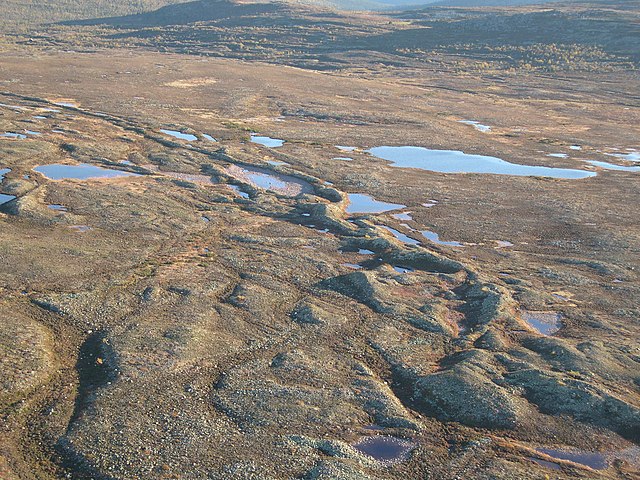Esker: Difference between revisions - Wikipedia
 Article Images
Article Images
Content deleted Content added
m Tags: Reverted Visual edit |
m |
||
| (13 intermediate revisions by 8 users not shown) | |||
Line 9: ==Etymology== [[File:Denaliesker.JPG|thumb|Portions of the [[Denali Highway]] in [[Alaska]] are built on eskers.]] The term ''esker'' is derived from the [[Irish language|Irish]] word | last =Quin | first =E. G. (gen. ed.) Line 18: | location =Dublin | pages =281 | isbn = 0-901714-29-1 }}</ref> The Irish word was and is used particularly to describe long sinuous ridges, which are now known to be deposits of [[fluvio-glacial]] material. The best-known example of such an ''eiscir'' is the ''[[Esker Riada|Eiscir Riada]]'', which runs nearly the whole width of [[Ireland]] from [[Dublin]] to [[Galway]], a distance of {{convert|200 The synonym ''os'' comes from the Swedish word ==Geology== Most eskers are argued to have formed within ice-walled tunnels by streams that flowed within and under glaciers. They tended to form around the time of the [[glacial maximum]], when the glacier was slow and sluggish. After the retaining ice walls melted away, stream deposits remained as long winding ridges. Eskers may also form above glaciers by accumulation of sediment in [[Jökulhlaup#Supraglacial and subglacial water flow|supraglacial channels]], in [[crevasse]]s, in linear zones between stagnant blocks, or in narrow embayments at glacier margins. Eskers form near the terminal zone of glaciers, where the ice is not moving as fast and is relatively thin.<ref name=Easterbrook>{{cite book Line 36: [[File:Esker-PB110050.JPG|thumb|Esker in [[Sims Corner Eskers and Kames]] National Natural Landmark, Washington, US. (Trees at the edge of the esker and the single lane road crossing the esker to the right of the photo provide scale.)]] Plastic flow and melting of the basal ice determines the size and shape of the subglacial tunnel. This in turn determines the shape, composition and structure of an esker. Eskers may exist as a single channel, or may be part of a branching system with [[tributary]] eskers. They are not often found as continuous ridges, but have gaps that separate the winding segments. The ridge crests of eskers are not usually level for very long, and are generally knobby. Eskers may be broad-crested or sharp-crested with steep sides.<ref name=Easterbrook/> They can reach hundreds of kilometers in length and are generally The path of an esker is governed by its water pressure in relation to the overlying ice. Generally, the pressure of the ice was at such a point that it would allow eskers to run in the direction of glacial flow, but force them into the lowest possible points such as valleys or river beds, which may deviate from the direct path of the glacier. This process is what produces the wide eskers upon which roads and highways can be built. Less pressure, occurring in areas closer to the [[glacial maximum]], can cause ice to melt over the stream flow and create steep-walled, sharply-arched tunnels.<ref>Shreve, R.L., 1985, Esker characteristics in terms of glacier physics, Katahdin esker system, Maine: GSA Bulletin, v. 96, pp. 639–646.</ref> Line 64: ===Europe=== In [[Sweden]], [[Uppsalaåsen]] stretches for {{convert|250|km|mi|abbr=on}} and passes through [[Uppsala]] city. The [[Badelundaåsen]] esker runs for over {{convert|300|km|mi|abbr=on}} from [[Nyköping]] to lake [[Siljan (lake)|Siljan]]. [[Pispala]]'s [[Pyynikki Esker]] in [[Tampere]], The village of [[Kemnay, Aberdeenshire|Kemnay]] in Aberdeenshire, Scotland has a {{convert|5
===North America=== [[Great Esker Park]] runs along the Back River in [[Weymouth, Massachusetts]], and is home to the highest esker in North America ({{convert|90 There are over 1,000 eskers in the [[U.S. state|state]] of [[Michigan]], primarily in the south-central [[Lower Peninsula]]. The longest esker in Michigan is the {{convert|22 Esker systems in the U.S. state of Maine can be traced for up to {{convert|100
[[Uvayuq]] or Mount Pelly, in [[Ovayok Territorial Park]], the Kitikmeot Region, [[Nunavut]] is an esker. Roads are sometimes built along eskers to save expense. Examples include the [[Denali Highway]] in [[Alaska]], the [[ There are numerous long eskers in the [[Adirondack State Park]] in upstate [[New York (state)|New York]]. The [[Rainbow Lake (New York)|Rainbow Lake]] esker bisects the eponymous lake and extends discontinuously for 85 miles (c. 137 km). Another long discontinuous esker extends from Mountain Pond through [[Keese Mill, New York|Keese Mill]], passing between [[Upper St. Regis Lake]] and the Spectacle Ponds, and continuing to Ochre, Fish, and Lydia Ponds in the [[Saint Regis Canoe Area|St. Regis Canoe Area]]. A 150-foot-high esker bisects the [[Five Ponds Wilderness Area]].<ref>{{Cite web|title = Sea Serpents in the Adirondacks? You Bet! |url = http://www.adirondackalmanack.com/2009/11/sea-serpents-in-the-adirondacks-you-bet.html|access-date = 2015-07-30|work=Adirondack Almanack| date=7 November 2009 }}</ref> ==See also== * {{annotated link|Eskers Provincial Park}} * {{annotated link|Glacial landform}} * {{annotated link|Glacier morphology}} Line 91: ==References== {{reflist|colwidth=30em}}▼ ==Further reading== * {{cite book | last = Trenhaile Line 102 ⟶ 104: | isbn = 978-0-19-542474-4 }} ▲{{reflist|colwidth=30em}} ==External links== Line 109: * [https://web.archive.org/web/20070607011324/http://www.maine.gov/doc/nrimc/mgs/explore/surficial/facts/surf-10.htm Oblique aerial photo of an esker in Waterford, Maine] * [http://homepage.eircom.net/~williamfinnerty/chaplefinnerty/esker/riada1.htm Esker Riada Webpage] * Diagram illustrating (i) tunnel in glacier before retreat of ice, forming (ii) meandering esker in * [https://web.archive.org/web/20081204092736/http://www.bridgenorthesker.ca/ The Bridgenorth Esker: geomorphology and sedimentology] | |||